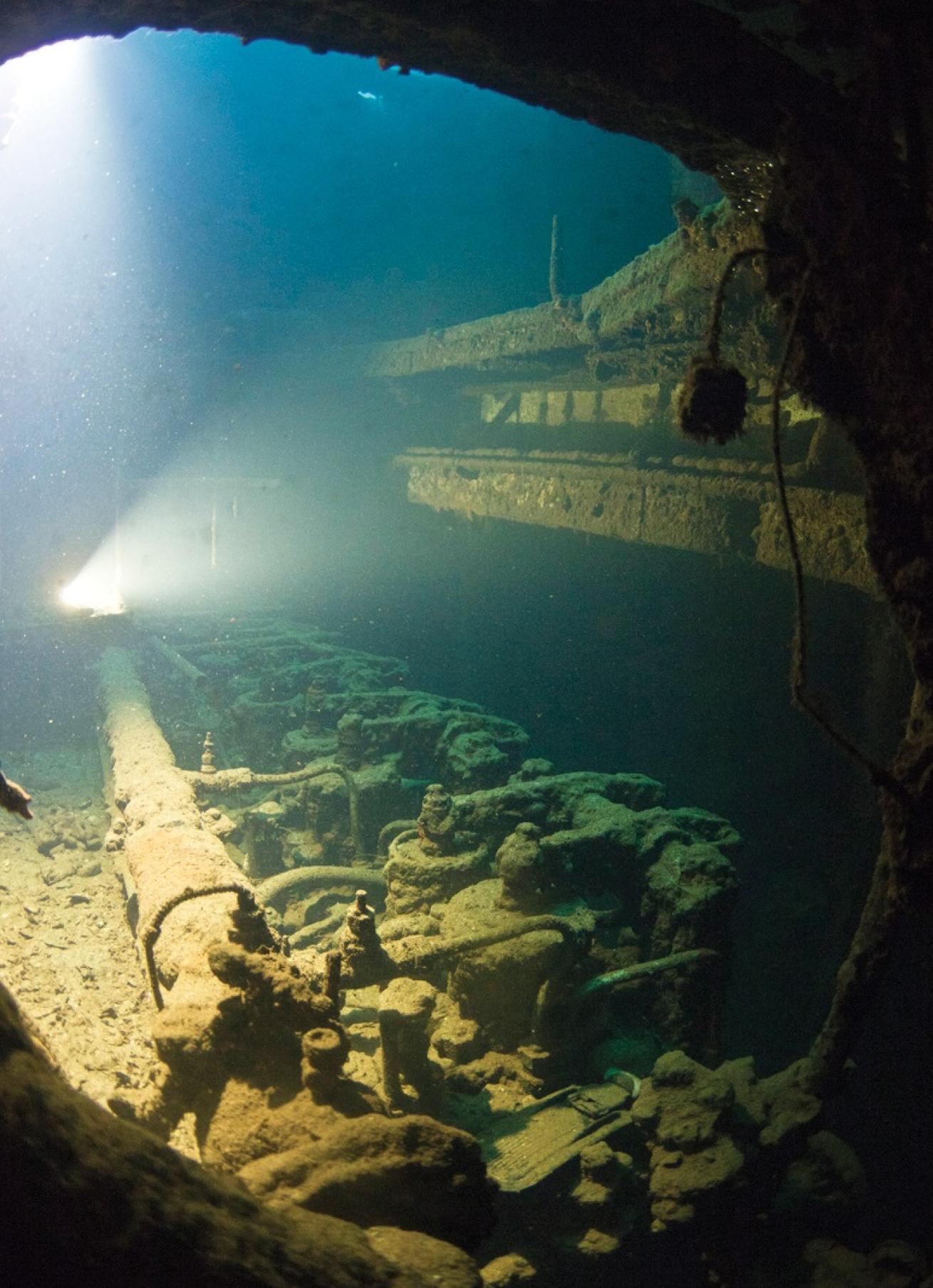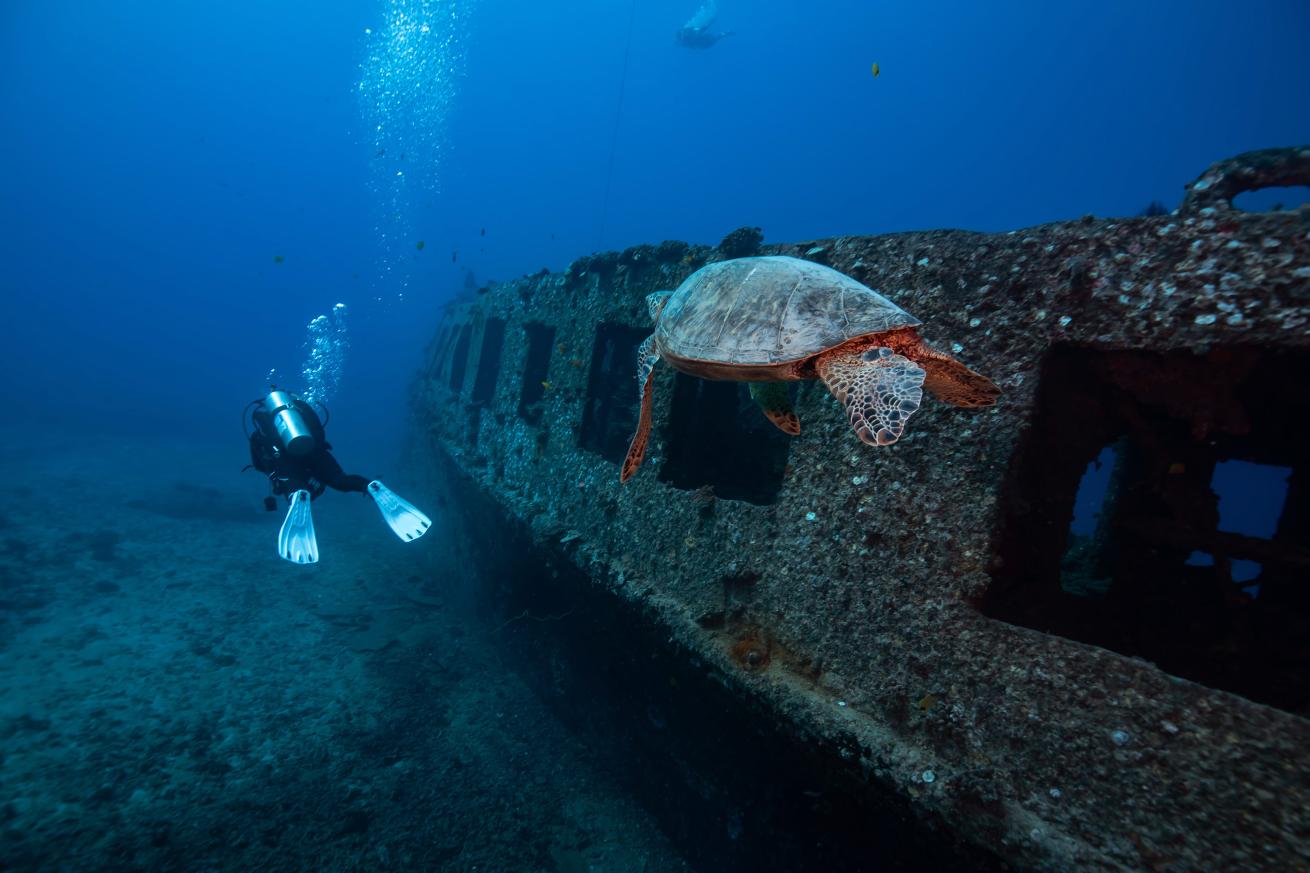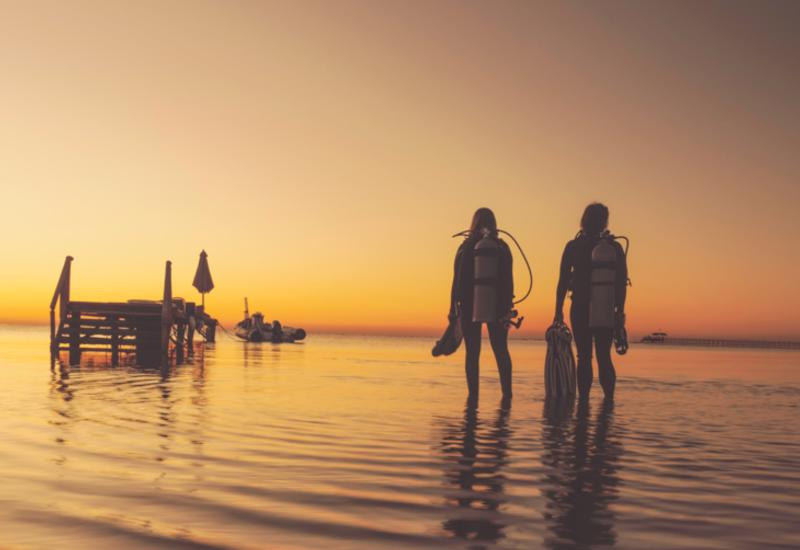7 Best Wrecks to Dive in Oahu, Hawaii

Jennifer PennerA green sea turtle—ubiquitous in Hawaii—on the wreck of the former Navy ship YO-257.
Metal in Paradise
Synonymous with Waikiki Beach, luaus, surfing and endemic wildlife, Hawaii’s third-largest island boasts the largest selection of recreational wreck dives in the state, making it a mecca for metal lovers who want a tropical dive vacation without having to travel too far from the continental United States. With most dive sites suited to open-water divers and several wrecks resting less than a 10-minute boat ride from shore, Oahu is the spot for those looking to dive a wreck for the first time. Meanwhile, avid wreck divers can tick off two and sometimes three wreck dives on a single two-tank trip.

Jeffrey MilisenThe engine room of the wreck.
Sea Tiger
Depth: 75 to 120 Feet
Length: 165 Feet
Year Sunk: 1999
Purpose Sunk
“Magnificent, huge. You’ve never seen anything like it.” That’s how Anna Kelly, owner of Waikiki Dive Center refers to this wreck.
The Sea Tiger was intentionally sunk in the waters just off Waikiki Beach, but it still has an interesting history. The vessel was originally confiscated in 1992 while being used to illegally transport more than 90 Chinese migrants into Hawaii.
After being cleaned up and sunk in 1999 as part of a dive enrichment effort, it has become home to a vast array of marine life, and it’s not uncommon to see a pod of dolphins, monk seals and groups of turtles. Whale sharks have even been spotted on rare occasions, Kelly says.
She recommends the 6:45 a.m. trip for the best chance at marine life encounters. “If you are willing to wake up early, the ocean is there, ready to welcome you with open arms and an abundance of marine life,” she says.

David FleethamA school of bluestripe snapper swarms the Sea Tiger.
Waikiki Dive Center makes the early departure time as seamless as possible by providing all dive gear in the price of a two-tank trip to the wreck. Besides the convenience factor for customers, this “valet service” is preferred by staff, who can know for sure that the gear has been properly cleaned and maintained, making it less likely someone will need to end a dive early due to an equipment malfunction.
The Sea Tiger rests in 110 feet of water, so every moment of bottom time is precious in order to explore as much of the wreck and find as many critters as possible.
The five-to 10-minute boat ride from Kewalo Basin is another reason for this highly requested site, often getting divers out to the wreck and back by 10:30 a.m. to enjoy the day’s activities.

Courtesy Rachel Winn / Aaron’s Dive ShopDeterioration of the Baby Barge has made it possible for divers to view the interior of the wreck from the outside.
Baby Barge
Depth: 65 to 75 feet
Length: About 80 feet
Year Sunk: 1994
Purpose Sunk
The Baby Barge wreck is best summed up by Teresa Kling, of Aaron’s Dive Shop: “Lots of turtles, and great for first-time wreck divers.”
Despite its name, it is a big wreck, sitting in fairly shallow water at 65 to 75 feet, which allows plenty of time for exploring. The nearby ridge line and turtle cave are adjacent to the barge, giving divers even more to see at this site.
The site is a well-known turtle cleaning station, making it a must for all the honu lovers out there. They are “super friendly and photogenic—they come right up to you,” says Rachel Winn, of Aaron’s Dive Shop.
The wreck is splayed open, so you can see the interior of the ship. There are no opportunities for wreck penetration, making it a great choice for beginners.
Besides turtles, the Baby Barge is unique because of a huge bush of black coral, which typically lives in very deep waters. The black coral here serves as habitat for the endemic longnose hawkfish, sought by photographers and critter hunters alike.
Sandbar sharks, slipper lobsters, trumpetfish—the marine life list goes on. Winn recalls once seeing a gray reef shark: “You can dive the same wreck a hundred times and never know what’s going to swim by.”

Courtesy Warren Murray / Aaron’s Dive ShopA diver investigates the remains of a World War II-era Corsair fighter plane strewn on the seafloor of Maunalua Bay at about 110 feet.
Corsair
Depth: 110 feet
Length: 30 feet
Year Sunk: 1945
True Wreck
This World War II-era fighter plane is arguably the most iconic of Oahu’s wrecks as it’s the only one that wasn’t sunk on purpose.
In 1945, an engine failure forced U.S. Marine Corps pilot William Holden to perform a water landing shortly after taking off from Molokai. He made it out safely, but the F4U-1A Corsair sank slowly to the bottom of the ocean. Rumor has it that his daughter went back and dived the wreck in the 1990s.
The Corsair is the dive most requested by patrons of Aaron’s Dive Shop. “The historical significance, the fact that this wreck is a plane and not a ship—aviation devotees, specifically, love diving this wreck,” says shop manager Rachel Winn.
One of the deeper wrecks in Oahu, the Corsair sits at about 105 to 110 feet of water, so you’ll get less bottom time here than at some of the other nearby sites. It’s not so deep that it excludes recreational divers, however.
Related Reading: Seeking Action-Packed Diving in Hawaii
The plane itself rests with one wing fully exposed and the other covered by sand, and you can often see eagle rays glide past, or slipper lobsters, nudibranchs and octopuses hiding in the wreckage, making it popular among underwater photographers and history junkies alike.
Winn says that when going up the mooring line from the site, divers have spotted sand tiger sharks, whale sharks and even a humpback in the past.
There is no reef directly next to the wreck, but if you look closely, you can spot a large colony of Hawaiian garden eels in the surrounding sand—if you’ve never seen them before, picture cute and whimsical dancing blades of grass.

Courtesy Teresa Kling / Aaron’s Dive ShopA diver fins over cement Z blocks while peering beneath the overturned LCU wreck.
LCU
Depth: 85 to 90 feet
Length: 119 feet
Year Sunk: 1998
Purpose Sunk
You’ll get out just fine if you have the experience and guide to dive this wreck that rests upside-down—and not in a Stranger Things kind of way—in 85 to 90 feet of water.
Originally built to transport military troops and vehicles to shore, this landing craft carrier, or LCU, is one of three donated by the Pearl Harbor Naval Shipyard to be used in Hawaii’s artificial reef program.
It was purpose-sunk in 1998 on a flat rubble plain, surrounded by sand and a field of artificial reef building blocks made from concrete that have attracted many fish over the years.
There are opportunities to penetrate the wreck with proper training and equipment. Its upside-down orientation on the seafloor creates a cave-like atmosphere. Most notably and reliably seen at the site are whitetip reef sharks either swimming among the rubble or resting underneath the bow section of the ship.
Most days, this wreck is combined with a reef dive, but Rachel Winn, of Aaron’s Dive Shop, says, “On special occasions, such as Veterans Day, we schedule two-tank wrecks backto-back.” She adds that wrecks on this side of the island typically feature only one mooring ball, creating a more serene experience.
Related Learning: Wreck Diver Specialty Course

Kristin PaterakisA turtle trails a diver alongside the wreck of the YO-257.
YO-257/San Pedro
YO-257 Depth: 100 to 120 feet
Length: 175 feet
Year Sunk: 1989
Purpose Sunk
San Pedro Depth: 85 Feet
Length: 111 Feet
Year Sunk: 1996
Purpose Sunk
If you are crunched for time and hoping to dive a twofer, then the YO-257 and neighboring San Pedro wreck should be at the top of your list when visiting Oahu.
The YO-257, the larger of the two wrecks at 175 feet long, is a former Navy yard oiler that delivered fuel to ships during World War II and the Korean War. It was intentionally sunk as an artificial reef in 1989.
The San Pedro, which was owned by a Korean fishing company, caught fire and was subsequently towed to Keehi Lagoon. It sat for years before it was intentionally sunk by Atlantis submarines in 1996.
Today, if you time your dives right, you can actually see the Atlantis tourist submarine while underwater. It’s always fun to see flashing cameras and tourists waving at you on your dive. If spotting the Atlantis submarine is a must, Anna Kelly, of Waikiki Dive Center, suggests booking a private charter.
As unique as it is to catch sight of a submarine on your dive, the real highlight is the marine life.
Large sea turtles, eagle rays, eels and whitetip sharks all call the YO-257 home. Brian Benton, of Dive Oahu, says, “Although the upper bridge came down and it may look different from the last time you dived it, the YO is still a gorgeous dive where you can see big turtles and eels.”
This massive ship sits approximately 100 feet away from the San Pedro, so it’s not uncommon for the same marine life to be seen at both wrecks. There’s a good chance for macro sightings of nudibranchs, leaf scorpionfish and frogfish if you keep your eyes peeled.

Jeffrey MilisenSoft corals cover the wheelhouse of the USS Nashua, a training site for Navy divers and a hotspot for underwater photographers.
Navy Tug
Depth: 65 feet
Length: 109 feet
Year Sunk: 2012
Purpose Sunk
Diving a Navy training site and a wreck dive in one day? It’s possible when the USS Nashua, aka Navy Tug, is on your dive itinerary.
Despite its status as an active training site for the U.S. Navy, this is a recreational dive that sits in 65 feet of water.
The tug is situated in the sand and is often visible the moment you dip your head underwater. In addition to an abundance of marine life, noticeable locked storage bins, used by the Navy for various training exercises, can be seen upon descent.
Related Reading: Dive Hacks: Tips for Wreck Diving
But the most exciting part about the 109-foot-long wreck is not its association with the Navy but the diverse marine life found living on it or just passing through, says Brian Benton, owner of Dive Oahu. “Because it’s next to a natural ledge, you tend to see fish life you don’t normally see,” he says. “We’ve spotted a humpback during whale season, mantas and lots of sharks swimming by.”
Although pelagic sightings are rarer, you are almost guaranteed to spot the resident moray eel near the propeller or the bow.
Over the years, soft coral growth has popped up, presenting unique opportunities for both wide-angle and macro photographers or shooters simply looking to add some color to wreck photos.
The site itself is about a 25- to 30-minute boat ride from Waikiki, making it less frequented by dive operators—and thus less crowded with divers.
Need to Know: Hawaii
When to Go
Hawaii’s dive season runs year-round.
Water Temps
Average of 75 degrees in winter and 80 degrees in summer
Viz
Greater than 50 feet, with many dive sites averaging 100 to 200 feet of visibility
PADI Training
Open Water Diver required; Advanced Open Water and Wreck Diver specialty recommended
Trip Tips
Pack layers! Though water temps range from the mid-70s to low-80s, you’ll want to bring a boat coat to wear topside when the sun disappears behind the clouds or winds pick up on the surface. Consider bringing a hooded vest to layer over your exposure suit underwater to stay comfortable during a day of multiple dives.










